7 Tips for Building a Multi-Channel Customer Support Strategy

Table of contents
Customers today use multiple channels to get support or assistance from your business. For instance, they could be on your website and want to quickly clarify something about a product using the live chat support option. Or they might email you and if you don’t respond on time, it’s likely that they’ll call your service centre.
The bottomline is simple: customers interact with your business in more ways than one.
That’s why it is important to have a multi-channel customer support strategy.
But what exactly is it and how do you create one?
In this article, we dive into what a multichannel strategy entails and some best practices to follow while implementin
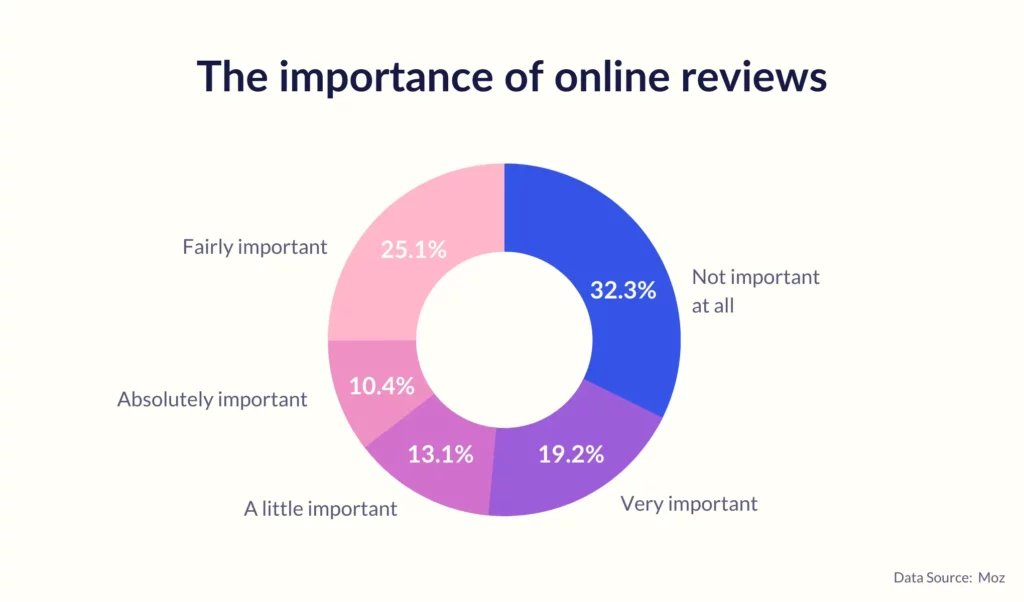
Table of Contents
- What is a multichannel support strategy?
- What are the benefits of multichannel support?
- Differences between multichannel support and omnichannel support
- How to build a multichannel customer support strategy
- 1. Remove silos and unify your approach to support
- 2. Integrate support with your product
- 3. Decide which type of queries work best for different types of queries
- 4. Get smart and pre-empt support before it’s needed
- 5. Use support to drive helpful content
- 6. Timing is everything, be known for quick responses
- 7. Organize support requests for the best outcomes for customers
- Conclusion
- Frequently Asked Questions (FAQs)
What is a multichannel support strategy?
A multichannel support strategy is an approach in which businesses use various communication channels to provide customer service.
It doesn’t matter what sort of business you run – whether it’s an e-commerce store like MyProtein, a B2B SaaS app like Notion, an online marketplace like Etsy, or something else entirely – support isn’t a one dimensional function.
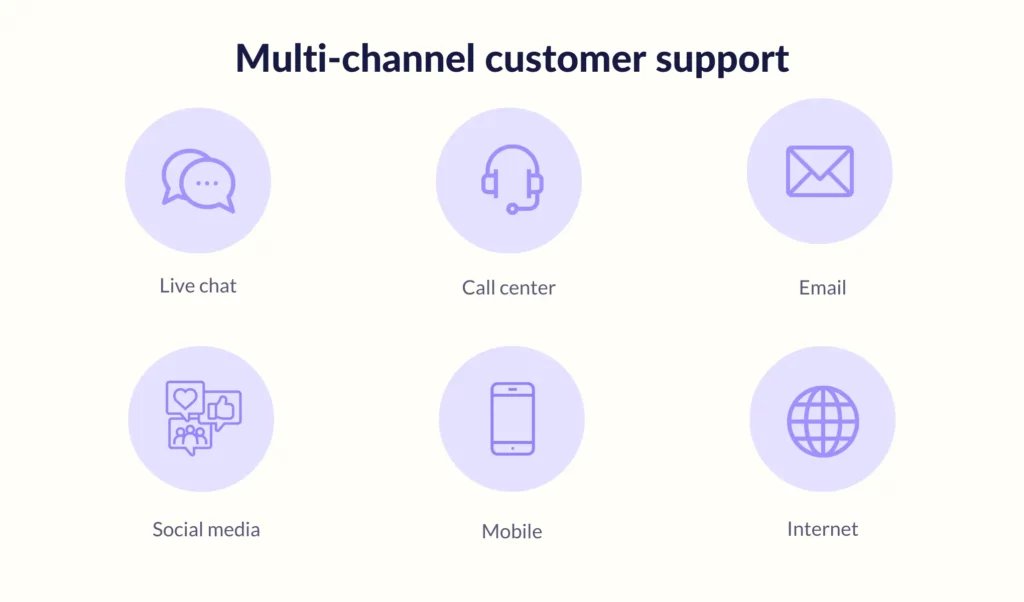
Instead support has multiple touchpoints. A multichannel support strategy entails providing seamless customer service and assistance across several different communications channels such as:
- Phone calls
- Call center
- SMS
- WhatsApp messaging
- Video
- Live chat and AI chatbot
- Social media
- Post / Letter
- In-person or in-store
- Knowledge base
This makes it easier to engage with your customers on channels they prefer, leading to a better overall experience.
What are the benefits of multichannel support?
A well-defined multichannel support strategy can have several benefits. Let’s take a look at some of them.
- Better accessibility: Multichannel support offers customers the option to reach out to their brands across their preferred channels and at their convenience.
- Improved customer satisfaction: Offering support and assistance across multiple channels ensures that customers receive timely responses to their queries.
- Better problem resolution: Different support channels work for different types of customer queries. For instance, complex technical issues may email support while basic queries can be addressed with the help of self-service portals.
- Valuable customer insights: Monitoring and tracking user interactions across various channels can give you insights into customer preferences, behavior, purchase history, etc. This can help you make tailored recommendations and launch personalized initiatives suited for different customer segments.
- Competitive advantage: Businesses that offer robust multichannel support have a better chance of meeting evolving customer expectations. This acts as a key differentiating factor and sets them apart from their competitors.
Differences between multichannel support and omnichannel support
Here is a quick comparison of the key differences between omnichannel and multichannel support.
| Aspects of support | Multichannel customer support | Omnichannel customer support |
|---|---|---|
Integration and consistency | Various channels used in support but each of them operate independently with little to no integration | Channels are synchronized and integrated in order to ensure continuity in customer experience |
| Quality of customer experience | Multiple options to interact with businesses. But may lead to disjointed experiences since channels are not integrated | Cohesive and seamless customer experience that allow customers to transition from one channel to the next without losing context |
| Accessibility to customer data | Support channels could be siloed from one another. This limits the seamless flow of customer data and information | Support channels are integrated together, creating a holistic view of the customer’s experience |
How to build a multichannel customer support strategy
Here are some of our favorite tips to help you build a well-structured multichannel customer support strategy.
1. Remove silos and unify your approach to support
Did you know that 70% of companies are a long way from having truly integrated support channels?
In most cases, your helpdesk is a silo.
This means, if you want to be part of the best in class, the bar is actually set pretty low at this stage, for you to gain an unfair advantage on your competitors.
To achieve integration of your support channels, one of the things you could consider is operating via a customer service solution that doesn’t silo information. By doing so, regardless of whether you’re receiving emails or live chat messages, they’re all under one roof for your team to manage.
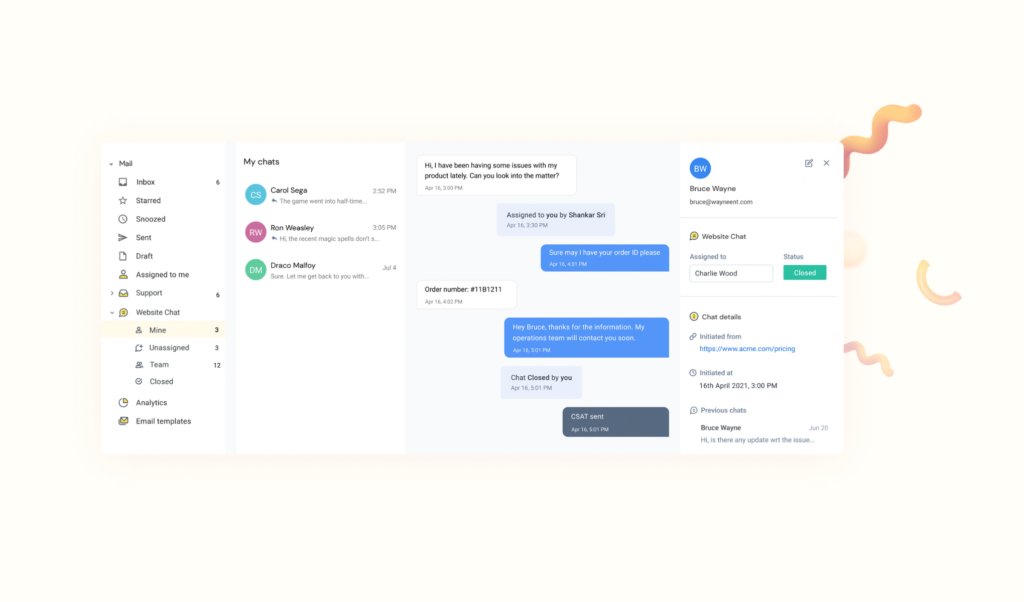
Don’t stop here though. Once you’ve removed your silos, it’s time to unify your approach.
The best support teams will design their customer interactions against 3 specific goals:
- First or initial response as fast as humanly possible.
- Being able to resolve the issue in a single interaction where possible.
- Ensuring SLAs are met. Every time.
By unifying your support channels against these specific goals, you’ll be well on your way to providing a consistently high quality multichannel customer service experience.
2. Integrate support with your product
Let’s say you have the best support offering ever. But if your customers can’t find where to access it, does it even exist?
Your customers shouldn’t need to hunt around your website, or even worse Google it, to find your support channels.
How? Take Zappos for example.
Zappos is known for delivering world-class support that wows customers.
Iif you visit their website, the first thing you will notice is a link to their customer service options (and yes, they offer multi-channel support). It’s not hidden in the footer or on a page that no one visits. It’s top left, above their company logo. You can’t miss it!
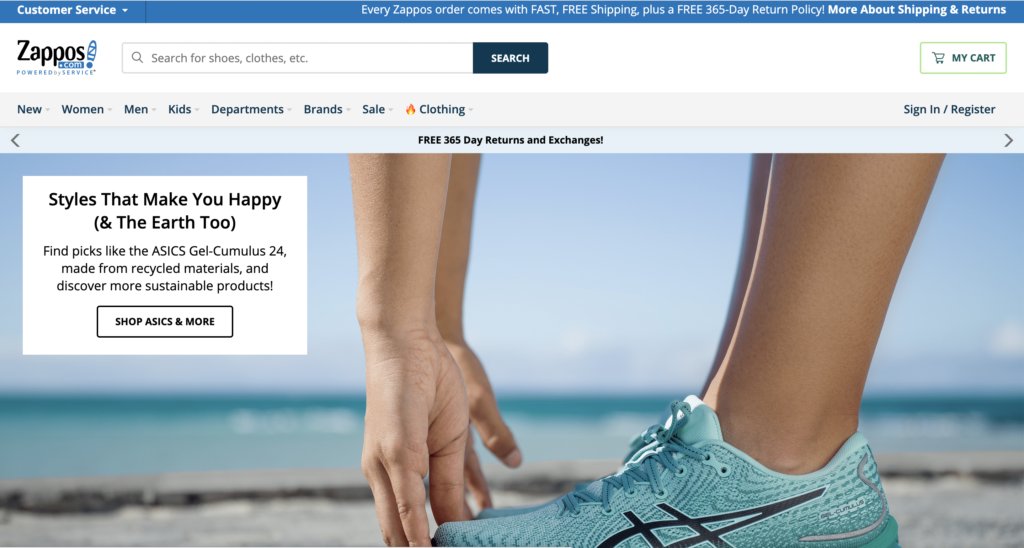
Another way to make support information easy to find is to integrate it directly into your product.
This means you should have links to your knowledge base in key menus, chatbot functionality in every possible digital channel, and a live chat widget on your website to make sure support is front and center of everything you do.
3. Decide which type of queries work best for different types of queries
Support channels shouldn’t be one size fits all. You need to tailor your approach according to the circumstance. This is because certain types of queries are better suited to some channels than others.
You’ve got to offer the most appropriate channel at the most appropriate time for the customer. This helps you meet customer expectations better and allows you to offer faster resolutions to their queries.
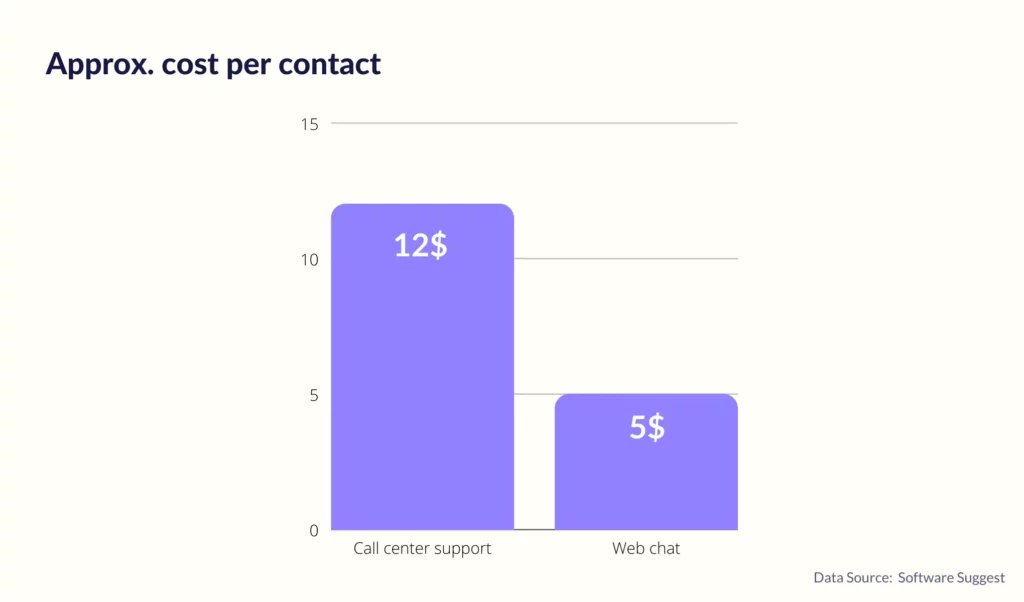
For example, if your customer has a quick query on how to do something in your app, then, Live Chat is going to be an effective channel to provide real-time support for both you and the customer.
However, if your customer has a complex enquiry all about the finer points of integrating with your API, email might be a better option.
Likewise, if your customer wants to talk about refunds, upgrades, or other financial transaction-related issues, then there really is no substitute other than speaking to someone on the phone.
Put simply, it’s all about taking your unified, multichannel approach to support, and putting yourself in the customer’s shoes to make sure it’s available in the right place at the right time.
4. Get smart and pre-empt support before it’s needed
The best support isn’t just about picking up the pieces after an issue has occurred.
Instead, the best form of support is one that is proactive and anticipates where customers might come unstuck, before they come unstuck.
This doesn’t mean hovering over your users and watching them use your product, waiting for a glitch to happen.
It means using what you know to help your customers help themselves.
Because 77% of people will stop using a platform in as little as one week – especially if they find it frustrating to use – it’s important to get this right.
Any support team worth their salt will recognise the areas of your product that customers trip over on, time and time again – causing frustration, support issues, and even churn.
The best support teams, however, will feed this information back into the product as things like tooltips on your website, mobile app, or desktop software.
There are several ways you could use tooltips. It could be the ‘choose a password’ screen for example, or even be part of your user onboarding.
Whatever you do, make sure that the tooltips you use are WCAG compliant to make sure they’re accessible, and therefore helpful, for all users.

5. Use support to drive helpful content
Because 48% of all support issues are ‘how to’ questions, it presents a fantastic opportunity for both support teams and their companies.
By spotting trends and patterns within these ‘how to’ questions, it enables savvy companies to develop content that answers these questions and make these answers accessible to customers.
We talked about tooltips earlier, but this is just the start of what is possible when it comes to content produced from support trends, which could include:
- Email newsletters – Many online companies use support issues as the basis for regular ‘support roundup’ or ‘how to’ email newsletters. In fact, it’s the first topic suggested in this list of newsletter ideas.
- Knowledge base articles and FAQs – It almost goes without saying, but as you solve new issues for customers, the content could and should be repurposed and used in your knowledge base portal. For instance, Hiver offers a powerful knowledge base feature that can help you create a centralized library of how-to guides, help articles, and more. It helps your customers self-serve and prevents your agents from having to work on repetitive queries. You can categorize questions to make it easier to find. Aside from this, if your customers can’t find exactly what they’re looking for, they can simply raise a ticket from within the knowledge base.

- Webinars and video – Sometimes there’s no substitute for showing someone exactly how to solve an issue. Using a webinar or series of pre-recorded videos is a great way to provide supportive content to your customers.
- Ebooks and guides – If you have a lot of information to convey on a particular topic, especially if it’s complex, then you might want to combine it all into an ebook or user guide. You can create free ebooks by using an ebook maker and can make this documentation available for download on your website, as well as encourage your support team to share it with customers.
- Not only will this content help your customers, but the upside for your company is a likely reduction in the number of support tickets and support costs
It’s also likely to increase customer retention and customer loyalty, too.
6. Timing is everything, be known for quick responses
When it comes to support, timing really is everything.
It sounds simple when you say it out loud, but how can you achieve it?
There are three things you can focus on:
- SLAs: Develop a realistic Service Level Agreement that your customers will accept and you can realistically stick to. This is a set of targets for metrics like response time and resolution time. based on the severity and priority order of support issues. Hiver allows you to set up SLAs to help your support team deliver timely resolutions. You can configure SLAs such that any time a query is not addressed on time, stakeholders are immediately notified via email with an ‘SLA Violation’ tag.

- Reporting and Metrics: Use reporting within your support tools to understand if and when you’re meeting your SLA targets. Monitor this religiously to manage the performance of your support team.
- Customer Satisfaction Surveys: As you continue to improve your response times, you’ll want evidence that this is delighting your customers. Use CSAT or Customer Satisfaction surveys after each support interaction to gather customer feedback and understand how happy (or otherwise) your customers were with the service they received.
Recommended Reading

7. Organize support requests for the best outcomes for customers
As we all know, the pandemic meant that products and services became more ‘digital first’ than ever before.
Because of this, the average support ticket volume that companies now receive has shot up 16% – and shows no signs of slowing down.

This means, it’s more important than ever to make sure your support offering is well organized and becomes a culture within your organization, rather than being siloed to one team.
Support teams shouldn’t feel they have to answer every ticket themselves, and your systems and processes should accommodate that.
For example, it should be easy for them to collaborate with other internal teams (i.e. engineering when it relates to software issues),ensuring a speedy resolution.
Another example:
You should be able to bring in subject matter experts, or escalate specific issues to specific departments, in order to deliver a seamless experience.
To help you do all this, make use of workflow functionalities such as automation and tagging in your customer support software.
Conclusion
Building a multichannel customer support strategy doesn’t need to be complicated.
Ultimately, it’s about helping your customers in a timely fashion, delivering a consistent experience, and using what you learn to keep improving what you’re doing.
By following our 7 tips and focusing on doing the simple things well, you’ll set yourself apart from your competitors and can retain your customers in the long run.
Book a demo todayto see how you can deliver multi-channel customer support with Hiver.
Frequently Asked Questions (FAQs)
- What is a multi-channel customer support strategy?
A multichannel support strategy helps businesses support customers across multiple channels such as live chat, email, and phone. With such a strategy you can bring these different channels under one unified view.
2. What are the key benefits of implementing a multichannel customer support strategy?
Key benefits of implementing a multichannel support strategy includes:
- Better accessibility to support for customers
- Improved customer satisfaction
- Faster problem resolution
- Shorter waiting times for customers
3. How can businesses determine which channels to include in their multi-channel support strategy?
Here are some ways to decide which channels to include in your multichannel support strategy:
- Understand your customers and assess their preferences, behavior, and requirements
- Evaluate customer feedback
- Analyze customer journeys to narrow down commonly used touch points
- Evaluate industry standards and trends
- Analyze channel capabilities
- Test and iterate to find the best performing channels
4. What are some common challenges businesses may face when implementing a multichannel support strategy?
Businesses often face challenges when implementing a multichannel support strategy. Some of them are:
- Maintaining consistency of customer support across different channels
- Managing resources effectively
- Integrating diverse systems and processes to ensure a cohesive customer experience
- Ensuring data security and privacy
5. How can businesses measure the success of their multichannel support strategy?
To measure the effectiveness of your multichannel support strategy, you will need to gather customer feedback and analyze every channel to identify areas for improvement.
You will also need to track metrics such as:
- CSAT
- Response times
- Resolution rates
- Channel utilization
- Customer retention
Resources you’ll love:

































